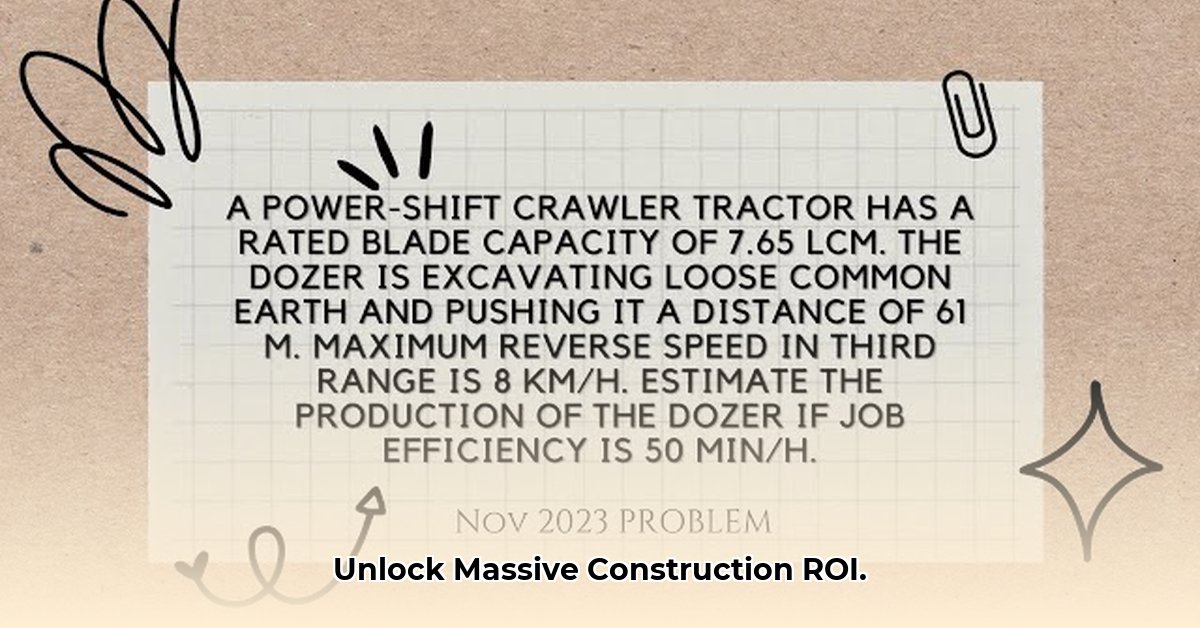
Power shift crawler tractors are indispensable on construction sites, but maximizing their return on investment (ROI) demands strategic cost and efficiency management. This guide provides actionable steps for construction companies, project managers, and government agencies to optimize crawler tractor usage and boost profitability. For more information on utility tractors, check out New Holland options.
Decoding the Costs of Power Shift Crawler Tractors
Understanding the total cost of ownership (TCO) is paramount. This encompasses several key components:
Purchase Price: The initial investment. Consider financing options, but remember to factor in total interest paid. A slightly higher upfront cost might yield greater long-term efficiency and durability.
Maintenance Costs: Regular maintenance (oil changes, filter replacements, inspections) is far cheaper than emergency repairs. Establish a preventative maintenance schedule and consider service contracts for added assurance. Don't neglect routine servicing – it's a crucial investment in preventing costly breakdowns.
Fuel Consumption: Fuel is a significant ongoing expense. Efficient operating practices and well-maintained equipment directly impact fuel economy. Consider the tasks your tractor will perform. Matching tractor size to the job reduces unnecessary fuel burn.
Operator Costs: Skilled operators are crucial for efficiency and minimizing wear and tear. Invest in training; skilled operators reduce fuel consumption and machine downtime, resulting in significant cost savings. Think of it as a critical investment in your workforce's capability, directly impacting your bottom line.
Depreciation: The tractor's value declines over time. This is unavoidable, but selecting the right-sized machine for the job minimizes depreciation and extends its useful life. Avoid overspending on equipment that's too powerful for your typical projects.
Boosting Efficiency: Practical Strategies for Maximizing ROI
Efficiency directly translates to higher profitability. Follow these steps to optimize your crawler tractor's performance:
Operator Training: Invest in comprehensive operator training programs to ensure efficient operation, minimizing fuel consumption and machine wear. A well-trained operator is invaluable for long-term cost savings.
Preventative Maintenance: Adhere to a rigorous maintenance schedule. Preventative maintenance is significantly more cost-effective than emergency repairs. Regular upkeep prevents costly downtime and keeps projects on schedule.
Job Site Planning: Meticulous job site planning minimizes wasted movements and maximizes workflow efficiency. Careful planning directly impacts project completion time and reduces unnecessary fuel consumption.
Right-Sizing Equipment: Select the appropriate tractor size for the job. Oversized equipment incurs unnecessary costs for fuel, maintenance, and depreciation. Matching tractor size to task size is crucial for optimizing costs and efficiency.
Technology Integration: Utilize GPS guidance, telematics, and other technologies to enhance accuracy, efficiency, and reduce material waste. Technology integration pays for itself through various cost savings over time, enhancing efficiency and reducing errors.
Real-World Examples: Proven Strategies for Success
Several construction firms have demonstrated the benefits of efficient crawler tractor management:
Company X: Implemented a rigorous preventative maintenance program, resulting in a 25% reduction in repair costs over three years.
Company Y: Invested in operator training, leading to a 15% increase in productivity and a 10% reduction in fuel consumption.
Company Z: Utilized GPS-guided machinery, reducing material waste by 12% and saving significant costs on a large-scale project.
Technology Integration: Leveraging Modern Tools
Modern technologies greatly improve efficiency and cost control:
GPS Guidance Systems: Enhance precision, minimize material waste, and reduce rework.
Telematics Systems: Provide real-time machine data for predictive maintenance, reducing downtime and repair costs.
Automated Systems: Some advanced machines offer automated functions, improving safety and efficiency.
Calculating Your Return on Investment (ROI)
ROI is the ultimate measure of success. Calculate your ROI using the following simplified formula:
ROI = (Revenue - Total Costs) / Total Costs
By focusing on efficiency and cost control, you'll significantly increase your ROI.
Managing Risk: Proactive Mitigation Strategies
Thorough risk assessment is vital:
| Risk Factor | Mitigation Strategy |
|---|---|
| Equipment Malfunction | Preventative maintenance, service contracts, emergency repair plans |
| Cost Overruns | Detailed budgeting, contingency planning, careful cost tracking |
| Labor Shortages | Competitive wages, training programs, employee retention strategies |
| Material Price Fluctuations | Long-term contracts with suppliers, market analysis, hedging |
| Regulatory Changes | Staying informed on regulations, compliance procedures |
| Weather Delays | Flexible scheduling, contingency plans for weather-related delays |
Proactive planning significantly minimizes risks and protects your investment.
Conclusion: Mastering Power Shift Crawler Tractors for Maximum Profitability
By implementing the strategies outlined in this guide, construction companies can drastically improve the efficiency and profitability of their power shift crawler tractors. Remember, it's an investment; maximizing returns requires careful planning, proactive maintenance, and a commitment to continuous improvement.